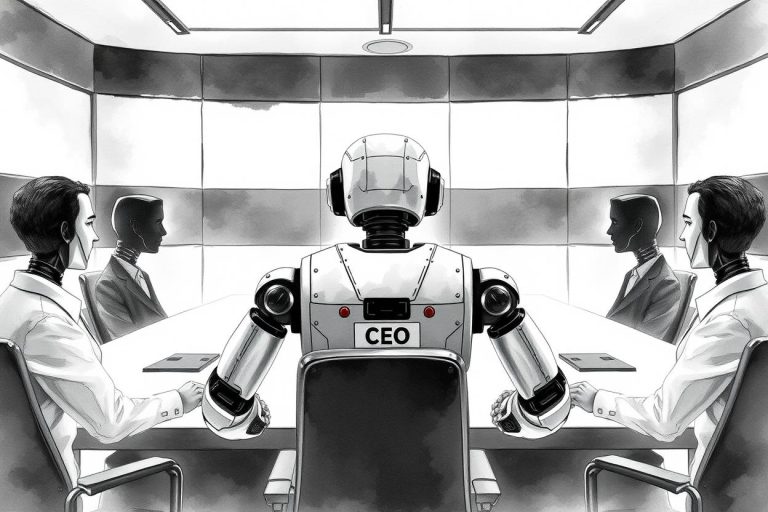How to become a better manager using AI – Top 6 strategies for better efficiency

The future of work is here, and it’s intelligent. Artificial intelligence (AI) isn’t just a buzzword; it’s a tool that is reshaping industries and redefining leadership. Imagine having a strategic partner who can analyze vast datasets in seconds, predict potential pitfalls, and even help you nurture top talent. That’s the power AI offers today’s managers.
Key Takeaways
- Data-Driven Decisions: Leverage AI to analyze information, uncover insights, and make informed choices – fast.
- Optimized Workflows: Streamline operations and boost productivity by automating repetitive tasks with AI.
- Personalized Development: Support your team with tailored learning plans for continuous growth.
- Enhanced Innovation: Spark creativity and accelerate innovation with AI-powered brainstorming and ideation.
- Ethical AI Integration: Build trust and transparency by prioritizing responsible AI practices and human oversight.
- Thriving Remote Teams: Foster connection and collaboration among hybrid and remote teams with AI-powered tools.
Here is our top 6 use cases on how to become a better manager using AI:
In this guide, we’ll cut through the hype and dive into six actionable strategies to elevate your management game. Prompt examples, practical use cases and actionable steps – no fluff. Our vision is to give you super powers through knowledge on how to use AI to become a better manager: think of it as a meritocratic approach to management – leveraging the best of human ingenuity and machine intelligence to achieve outstanding results.
Decision-Making: Beyond Gut Instinct, Into Data-Driven Clarity
The managerial role offers rewards, but let’s be real: the pressure to make the right call can be quite a heavy burden, especially if you’re a founder or solopreneur. What if you had a tool that could process massive amounts of information, free from emotional bias, to help you make smarter choices and spot potential pitfalls? It’s worth considering how AI could transform your leadership.
- AI-powered decision making
AI enables managers to move beyond intuition and make informed decisions based on data-driven insights at a faster pace. Now is possible to analyze vast amounts of information and find patterns, trends, and correlations that the eye might miss.
Prompt Example: “Analyze our sales data from the past two years, incorporating external market trends and competitor analysis. Identify top-performing products, underperforming regions, and emerging customer segments. Provide a detailed report with actionable recommendations for revenue growth, including pricing adjustments, targeted marketing campaigns, and new product development opportunities.”
- Real-time Risk Assessment:
AI-powered scenario planning and risk assessment tools can simulate various outcomes, helping managers identify potential risks and develop effective mitigation strategies.
Prompt Example: “Given our current financial projections, assess the potential impact of a 20% increase in raw material costs, a 15% decline in consumer spending, and a new competitor entering the market. Generate a comprehensive risk assessment report outlining the likelihood and impact of each scenario, along with prioritized mitigation strategies.”
Action Plan for Decision-Making:
- Define the decision scope: Clearly articulate the specific decision you need to make or the problem you need to solve.
- Identify relevant data sources: Determine which internal and external data sources are relevant to your decision (e.g., sales data, market research, competitor analysis).
- Collect and preprocess data: Gather the necessary data and ensure it’s in a format that can be easily analyzed by AI tools (e.g. PDF, CSV)
- Select the appropriate AI tool: Choose an AI platform or model that is suitable for the type of analysis you need (e.g., predictive analytics, risk assessment, bias detection, general use chatbot).
- Craft a detailed and specific prompt: Clearly define the desired outcome, the specific questions you want the AI to answer, and any relevant parameters or constraints.
- Iterate and refine: Experiment with different prompts and parameters to fine-tune the AI’s output and ensure it aligns with your needs.
- Evaluate the AI-generated insights: Carefully review the AI’s findings, considering their implications and potential impact on your decision.
- Incorporate AI insights into your decision-making process: Use the AI-generated information to inform your final decision, but remember to apply your own expertise and judgment.
AI-Powered Team Dynamics: Building High-Performance Teams
Effective communication and collaboration are the bedrock of any successful team. However, navigating team dynamics, fostering trust, and resolving conflicts can be challenging, especially in remote or hybrid workplace environments. AI can be a powerful ally in building and maintaining high-performing teams by providing insights into personality traits, communication styles, and potential areas of friction.
- Personality Profiling and Team Matching:
AI-powered personality assessments can go beyond simple Myers-Briggs types to offer deeper insights into individual work styles, communication preferences, and potential strengths and weaknesses. By analyzing this data, AI can help managers create teams that are not only diverse but also complementary, fostering a collaborative environment where everyone’s strengths are leveraged and weaknesses are compensated for.
Prompt Example: “Analyze the personality profiles of our team members, including their communication styles, work preferences, and potential areas of conflict. Based on this analysis, suggest optimal team configurations for [project description], considering both individual strengths and the overall team dynamics required for success.”
Action plan for building high-performance teams
- Administer Personality Assessments: Have team members complete a comprehensive personality assessment tool that measures various traits, such as extroversion, agreeableness, conscientiousness, openness, and neuroticism.
- Gather Additional Data: Collect data on individual communication styles, work preferences (e.g., independent vs. collaborative), and past project performance.
- Utilize AI for Analysis: Input the assessment results and additional data into an AI tool like ChatGPT or Gemini. Use the prompt to analyze the data and identify patterns, correlations, and potential areas of conflict or synergy.
- Formulate Optimal Team Configurations: Based on the AI’s insights, create team structures that maximize individual strengths and minimize potential conflicts. Consider factors such as project requirements, skill sets, and communication preferences. Refine the final team based on your experience and insights.
- Communicate and Adapt: Share the rationale behind team assignments with team members and be open to feedback and adjustments as needed. Continuously monitor team dynamics and leverage AI to address any emerging challenges.
AI-Driven Employee Empowerment: Unleashing Human Potential
Today’s successful managers empower their teams by fostering a culture of continuous learning, growth, and recognition. AI can be a powerful ally in this endeavor, providing personalized insights and tools that help employees reach their full potential.
- Skills Mapping and Development:
AI can act as a personal career coach for each employee, identifying their strengths, weaknesses, and untapped potential. By analyzing performance data, skill assessments, and career aspirations, AI can recommend tailored learning paths that align with both individual goals and company needs.
Prompt Example: “Analyze [employee name]’s skills, experience, and career aspirations. Identify potential areas for growth and recommend personalized learning resources, courses, or certification programs that will enhance their skillset and contribute to their professional development.”
Action plan for Employee Empowerment
- Comprehensive Skills Assessment: Conduct thorough skills assessments for each team member, utilizing a combination of self-assessments, manager evaluations, and standardized tests.
- Data Integration: Integrate this data with information from performance reviews, project outcomes, and career development discussions.
- AI-Powered Analysis: Leverage AI tools to analyze this data and identify skill gaps, areas of expertise, and potential career paths for each employee.
- Personalized Development Plans: Create customized learning plans that address individual skill gaps and align with career aspirations. This can include online courses, workshops, mentorship programs, or job shadowing opportunities.
- Continuous Monitoring and Adjustment: Regularly track employee progress and adjust development plans as needed. Encourage employees to take ownership of their learning journey and seek out opportunities for growth.
By embracing AI-driven employee empowerment, managers can cultivate a high-performing team where each individual feels valued, supported, and motivated to reach their full potential. This approach not only benefits the employees themselves but also translates into increased productivity, innovation, and overall success for the organization.
AI-Enhanced Creativity and Innovation

For modern business innovation is the lifeblood of growth and sustainability. Artificial Intelligence is not just a tool for automation; it’s a catalyst for creative thinking, ideation and problem-solving, enabling teams to break free from conventional constraints and explore uncharted territories.
- Idea Generation and Brainstorming:
Supercharge your brainstorming sessions, generating a wealth of diverse and unexpected ideas. By digging into the depth of their training data, powerful LLMs such as ChatGPT, Gemini or Llama can provide outside the box ideas for your purpose – if you are using the right prompting and go beyond the general and obvious.
Prompt Example: “Our company is looking to expand into the [new market/industry]. Brainstorm innovative product or service ideas that cater to this market’s unique needs and preferences. [Add further data, insights, successful brand stories from competition or effective marketing strategies in order to get better results]”
Action plan for ideas generation
- Define the Problem: Clearly articulate the problem or opportunity you want to address through innovation.
- Gather Relevant Data: Collect data from diverse sources, such as market research, customer feedback, competitor analysis, and industry trends.
- Utilize AI Ideation Tools: Input the problem statement and relevant data into an AI-powered brainstorming software of choice. Use the prompt to generate a wide range of ideas, exploring different angles and perspectives.
- Evaluate and Prioritize: Review the AI-generated ideas and prioritize those with the highest potential for impact and feasibility.
- Refine and Develop: Work with your team to refine the most promising ideas, fleshing out details and exploring potential implementation strategies.
AI-Powered Customer Service and Experience
In the world where choices abound, customer experience can be one of the key differentiator between success and failure. As the implementation of AI in customer service increases and becoming the norm, is important to implement it successfully (think smart chatbots, rather than the one going in circle and only provides frustration) by putting yourself in your customer’s shoes.
- Beyond Basic Chatbots: Personalized, Proactive Support:
By leveraging natural language processing, sentiment analysis, and machine learning, AI-powered tools can understand customer needs, anticipate their questions, and provide tailored solutions and suggestions in real time. They are far from perfect, but they are progressing very fast in their efficiency.
Prompt Example: “Analyze customer interactions across various channels (chat, email, social media). Identify common pain points, recurring questions, and opportunities for improvement in our customer service experience.”
Action plan for improving customer experience
- Gather Customer Interaction Data: Collect data from all customer touchpoints, including chat transcripts, email exchanges, social media conversations, and customer feedback surveys.
- Utilize AI for Analysis: Employ AI-powered tools to analyze the data, identifying patterns, trends, and areas where customer experience can be enhanced.
- Implement AI-Powered Solutions: Deploy AI chatbots, virtual assistants, or recommendation engines to provide personalized support, answer questions, and suggest relevant products or services.
- Create better FAQs: Understanding your customers will give you the power to answer their questions more accurately and with less friction. Use AI to be more effective and increase customer satisfaction.
- Monitor and Optimize: Continuously track customer satisfaction metrics and use AI-driven insights to optimize your customer service processes and improve the overall customer experience.
AI for Operational Efficiency

Being efficient seems like a mantra of the modern managers and for good reasons: efficiency would save you money, time and will allow you to focus on what matters the most, which is growing the business at faster pace.
- Streamlining Processes and Reducing Costs:
AI is reshaping how businesses operate by automating repetitive tasks, optimizing complex workflows, and uncovering hidden inefficiencies. This liberates valuable human resources to focus on strategic initiatives, fosters cost savings, and drives operational excellence.
Prompt Example: “Analyze our current [invoice processing/customer onboarding/inventory management] workflow, pinpoint bottlenecks and redundancies. Propose actionable steps to automate or streamline these processes using AI, estimating potential time, ROI and cost savings.”
Action plan on AI for operational efficiency (AI Automation)
- Process Mapping: Meticulously document your existing workflow, including all steps, inputs, outputs, decision points, and associated timelines.
- Data Gathering: Collect comprehensive data on key performance indicators (KPIs) like processing time, error rates, resource utilization, and customer feedback.
- AI-Powered Analysis: Input the workflow documentation and performance data into an AI tool. Utilize the prompt to identify bottlenecks, redundancies, and opportunities for automation or optimization.
- Tool Selection and Implementation: Explore AI-powered tools or platforms that can automate specific tasks, streamline workflows, or provide real-time insights into process performance. Carefully select the tools that align with your organization’s needs and budget.
- Gradual Implementation: Introduce AI-driven changes incrementally, testing and refining them along the way to ensure seamless integration with existing processes and minimize disruption.
- Monitoring and Measurement: Continuously track the impact of AI-driven improvements on efficiency, cost reduction, and overall operational performance. Use data-driven insights to further refine and optimize processes.
Conclusion: The Time for AI Leadership is Now
AI is changing the way we work and lead. It’s not about replacing you, but about making you a better manager. By using AI strategically and ethically, you can boost productivity, build stronger teams, and spark innovation. Don’t get left behind. Embrace AI today, educate yourself on the topic and lead your company into a smarter future.




